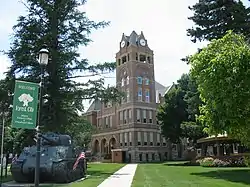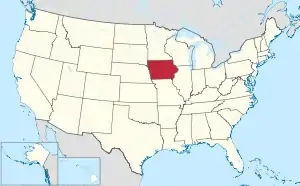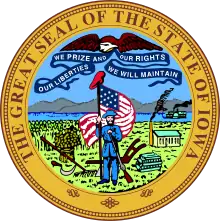Winnebago County, Iowa
Winnebago County is a county in the U.S. state of Iowa. As of the 2010 census, the population was 10,866.[1] The county seat is Forest City.[2] The county was founded in 1847 and named after the Native American tribe. It is the location of the motor homes manufacturer Winnebago Industries.
Winnebago County | |
|---|---|
| Winnebago County | |
 Winnebago County Courthouse in Forest City | |
 Location within the U.S. state of Iowa | |
 Iowa's location within the U.S. | |
| Coordinates: 43°22′44″N 93°43′55″W | |
| Country | |
| State | |
| Founded | 1847 |
| Named for | Winnebago tribe |
| Seat | Forest City |
| Largest city | Forest City |
| Area | |
| • Total | 402 sq mi (1,040 km2) |
| • Land | 400 sq mi (1,000 km2) |
| • Water | 3.3 sq mi (9 km2) 0.3% |
| Population (2010) | |
| • Total | 10,866 |
| • Estimate (2018) | 10,518 |
| • Density | 27/sq mi (10/km2) |
| Time zone | UTC−6 (Central) |
| • Summer (DST) | UTC−5 (CDT) |
| Congressional district | 4th |
| Website | www |
Geography
According to the U.S. Census Bureau, the county has an area of 402 square miles (1,040 km2), of which 400 square miles (1,000 km2) is land and 1.2 square miles (3.1 km2) (0.3%) is water.[3] It is Iowa's fifth-smallest county by land area and second-smallest by total area.
Adjacent counties
- Faribault County, Minnesota (northwest)
- Freeborn County, Minnesota (northeast)
- Worth County (east)
- Hancock County (south)
- Kossuth County (west)
- Cerro Gordo County (southeast)
Demographics
| Historical population | |||
|---|---|---|---|
| Census | Pop. | %± | |
| 1860 | 168 | — | |
| 1870 | 1,562 | 829.8% | |
| 1880 | 4,917 | 214.8% | |
| 1890 | 7,325 | 49.0% | |
| 1900 | 12,725 | 73.7% | |
| 1910 | 11,914 | −6.4% | |
| 1920 | 13,489 | 13.2% | |
| 1930 | 13,143 | −2.6% | |
| 1940 | 13,972 | 6.3% | |
| 1950 | 13,450 | −3.7% | |
| 1960 | 13,099 | −2.6% | |
| 1970 | 12,990 | −0.8% | |
| 1980 | 13,010 | 0.2% | |
| 1990 | 12,122 | −6.8% | |
| 2000 | 11,723 | −3.3% | |
| 2010 | 10,866 | −7.3% | |
| 2018 (est.) | 10,518 | [4] | −3.2% |
| U.S. Decennial Census[5] 1790-1960[6] 1900-1990[7] 1990-2000[8] 2010-2018[1] | |||
2010 census
The 2010 census recorded a population of 10,866 in the county, with a population density of 27.1331/sq mi (10.4762/km2). There were 5,194 housing units, of which 4,597 were occupied.[9]
2000 census

At the 2000 census there were 11,723 people, 4,749 households, and 3,181 families in the county. The population density was 29 people per square mile (11/km2). There were 5,065 housing units at an average density of 13 per square mile (5/km2). The racial makeup of the county was 97.37% white, 0.18% black or African American, 0.23% Native American, 0.72% Asian, 0.01% Pacific Islander, 1.01% from other races, and 0.49% from two or more races. 2.02% of the population were Hispanic or Latino of any race.[10] Of the 4,749 households 30.60% had children under the age of 18 living with them, 56.90% were married couples living together, 7.20% had a female householder with no husband present, and 33.00% were non-families. 29.40% of households were one person and 14.70% were one person aged 65 or older. The average household size was 2.36 and the average family size was 2.91.
The age distribution was 24.10% under the age of 18, 9.80% from 18 to 24, 24.10% from 25 to 44, 23.10% from 45 to 64, and 18.90% 65 or older. The median age was 40 years. For every 100 females there were 95.50 males. For every 100 females age 18 and over, there were 92.90 males.
The median household income was $38,381 and the median family income was $47,306. Males had a median income of $30,720 versus $22,509 for females. The per capita income for the county was $18,494. About 5.00% of families and 8.40% of the population were below the poverty line, including 11.90% of those under age 18 and 8.20% of those age 65 or over.
Communities
Population ranking
The population ranking of the following table is based on the 2010 census of Winnebago County.[11]
† county seat
| Rank | City/Town/etc. | Municipal type | Population (2010 Census) |
|---|---|---|---|
| 1 | † Forest City (partially in Hancock County) | City | 4,151 |
| 2 | Lake Mills | City | 2,100 |
| 3 | Buffalo Center | City | 905 |
| 4 | Thompson | City | 502 |
| 5 | Leland | City | 289 |
| 6 | Rake | City | 225 |
| 7 | Scarville | City | 72 |
Politics
| Year | Republican | Democratic | Third Parties |
|---|---|---|---|
| 2016 | 59.6% 3,447 | 33.4% 1,931 | 7.1% 409 |
| 2012 | 49.1% 2,906 | 49.1% 2,903 | 1.8% 109 |
| 2008 | 44.9% 2,730 | 53.5% 3,254 | 1.7% 101 |
| 2004 | 53.3% 3,175 | 45.5% 2,707 | 1.2% 70 |
| 2000 | 48.2% 2,662 | 48.7% 2,691 | 3.2% 174 |
| 1996 | 40.1% 2,211 | 48.5% 2,679 | 11.4% 631 |
| 1992 | 39.6% 2,407 | 38.2% 2,322 | 22.2% 1,349 |
| 1988 | 50.2% 2,863 | 49.2% 2,804 | 0.6% 36 |
| 1984 | 57.3% 3,616 | 42.3% 2,669 | 0.5% 29 |
| 1980 | 58.8% 3,808 | 34.1% 2,208 | 7.2% 463 |
| 1976 | 52.2% 3,315 | 46.5% 2,950 | 1.3% 81 |
| 1972 | 64.5% 4,300 | 34.9% 2,324 | 0.7% 45 |
| 1968 | 59.5% 3,543 | 36.3% 2,163 | 4.2% 248 |
| 1964 | 38.7% 2,331 | 61.1% 3,677 | 0.2% 9 |
| 1960 | 62.3% 4,082 | 37.6% 2,463 | 0.1% 4 |
| 1956 | 60.8% 3,926 | 39.1% 2,521 | 0.1% 6 |
| 1952 | 70.4% 4,574 | 29.3% 1,905 | 0.3% 20 |
| 1948 | 48.4% 2,636 | 48.2% 2,626 | 3.5% 189 |
| 1944 | 51.2% 2,808 | 48.4% 2,654 | 0.3% 18 |
| 1940 | 51.8% 3,308 | 47.8% 3,051 | 0.5% 29 |
| 1936 | 43.7% 2,592 | 52.9% 3,133 | 3.4% 202 |
| 1932 | 36.6% 2,012 | 59.7% 3,281 | 3.8% 206 |
| 1928 | 70.1% 3,386 | 26.3% 1,268 | 3.7% 177 |
| 1924 | 47.3% 2,445 | 4.4% 225 | 48.4% 2,502 |
| 1920 | 87.1% 3,931 | 10.4% 469 | 2.5% 114 |
| 1916 | 72.9% 1,713 | 24.9% 584 | 2.2% 52 |
| 1912 | 23.9% 532 | 17.5% 390 | 58.7% 1,309 |
| 1908 | 76.1% 1,710 | 21.8% 489 | 2.2% 49 |
| 1904 | 89.5% 2,002 | 7.8% 174 | 2.8% 62 |
| 1900 | 79.6% 2,052 | 18.4% 474 | 2.0% 51 |
| 1896 | 72.1% 1,912 | 26.9% 714 | 0.9% 25 |
References
- "State & County QuickFacts". United States Census Bureau. Retrieved July 20, 2014.
- "Find a County". National Association of Counties. Retrieved June 7, 2011.
- "US Gazetteer files: 2010, 2000, and 1990". United States Census Bureau. February 12, 2011. Retrieved April 23, 2011.
- "Population and Housing Unit Estimates". Retrieved June 25, 2019.
- "U.S. Decennial Census". United States Census Bureau. Retrieved July 20, 2014.
- "Historical Census Browser". University of Virginia Library. Retrieved July 20, 2014.
- "Population of Counties by Decennial Census: 1900 to 1990". United States Census Bureau. Retrieved July 20, 2014.
- "Census 2000 PHC-T-4. Ranking Tables for Counties: 1990 and 2000" (PDF). United States Census Bureau. Retrieved July 20, 2014.
- "Population & Housing Occupancy Status 2010". United States Census Bureau American FactFinder. Retrieved June 18, 2011.
- "U.S. Census website". United States Census Bureau. Retrieved January 31, 2008.
- https://www.census.gov/2010census/
- Leip, David. "Dave Leip's Atlas of U.S. Presidential Elections". uselectionatlas.org. Retrieved April 28, 2018.
External links
| Wikimedia Commons has media related to Winnebago County, Iowa. |
